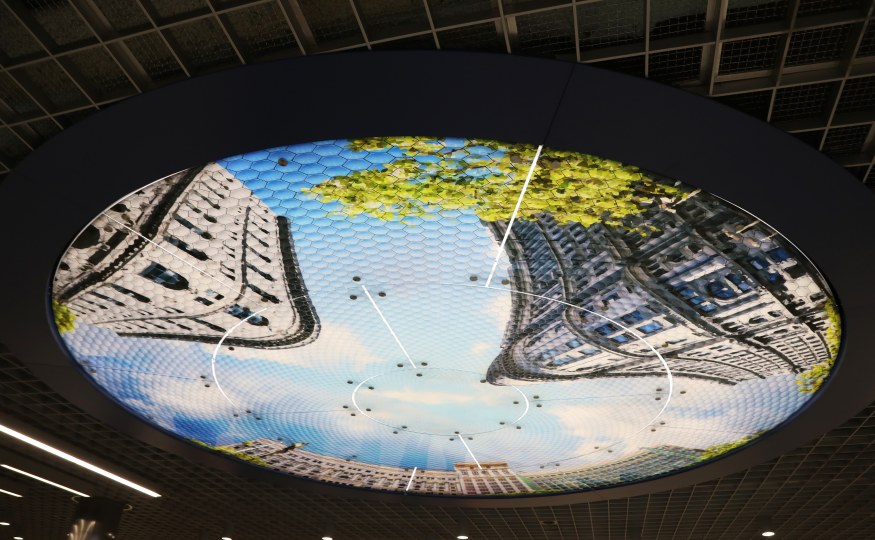New illuminated artwork brings the sky to Powell St. Station
 A shining blue sky now illuminates Powell St. Station.
A shining blue sky now illuminates Powell St. Station.
In November, as part of the Powell St. Modernization Plan, BART installed a stunning new artwork at the station. You’ll have to look up to see this one; the piece, created by San Francisco artist Stephen Galloway and coordinated by the BART Art Program, is installed on the ceiling.
Titled “Elysium,” the artwork features an illuminated sky ringed by imagery of three of the historic buildings around the station entrance. When you look up at “Elysium,” it’s as if you’re emerging from the station onto bustling Market Street around you.
The work itself is a large LED lightbox. The imagery is digitally printed onto film and the film is squished between two panes of glass like a sandwich, Galloway said. Light from LEDs peeks through the somewhat translucent glass to illuminate the image.
Installing the artwork was challenging, according to Wahid Amiri, who managed the project. The piece is located at the former site of a breakroom and structure that held ticketing machines. All of that had to be removed, and the area had to be abated for hazardous materials, as well as cleaned and fireproofed. Once that was finished, electricians installed the wiring for the LED panel. Then the heavy lifting began, as the glass panels of the piece – all 13 of them – weighed about 150 pounds.
Amiri stressed the installation process was “very delicate.”
“The last thing we wanted was for that glass to be shattered,” he said.
Galloway spoke of the piece as helping to establish a “sense of place,” a multivalent construct that describes people’s connection to space. In Galloway’s phrasing, sense of place enables us to “lock in with the meaning of a space.”
“It’s getting people to both be aware but also feel good about what’s around them,” he said.
For Galloway, Powell St. Station is a central hub of urban activity and motion. It’s also the first experience of San Francisco many visitors have.
“I’m really trying to affect that first moment as people come off these trains for their first taste of San Francisco,” Galloway said.
To create the artwork itself, Galloway began by walking. He strolled the neighborhood around Powell St. for hours, covering about eight blocks by eight blocks in each direction, to get a sense of what a person would feel and notice while ambling around the area. Much of Galloway’s art considers nature, but around Powell St., the artist said he was mostly inspired by the architecture.
Once Galloway had a concept, he started taking hundreds of photographs of the buildings around Powell St. He brought those photos back to his studio, where he roughly collaged a composition and then created a digital graphic.
“It no longer has photographic detail at that point,” Galloway said. “It looks much more like dabs of color.”
Astute viewers will notice a not-so-subtle detail in the piece that pays homage to the original architecture of the station. The artwork has the illusion that it’s made not of glass, but the iconic raised “bubble tiles” found along the walls at Powell St. Station.
“There’s nothing like them,” Galloway said. “If you go to a tile store, you won’t see these.”
Galloway superimposed the pattern of the tiles, with their little bits of shadow, over the digital piece and voila – the illusion of raised tile. The creative decision, an obvious homage to BART, also references the history of mosaic, which Galloway called “a super important part of public art” that’s been used for more than 2,000 years.
“It just seemed like the right thing to do,” Galloway said.
In all, Galloway hopes the piece encourages BART riders to look at their surroundings and, perhaps, reconsider the history and splendor of Market Street.
He asks: “How can we do right by all that heritage?”
For Amiri, the station modernization will make Powell St. a “beautiful location for families to visit and take photos.”
“This just adds a layer of beautifying the station and making it a destination,” he said.